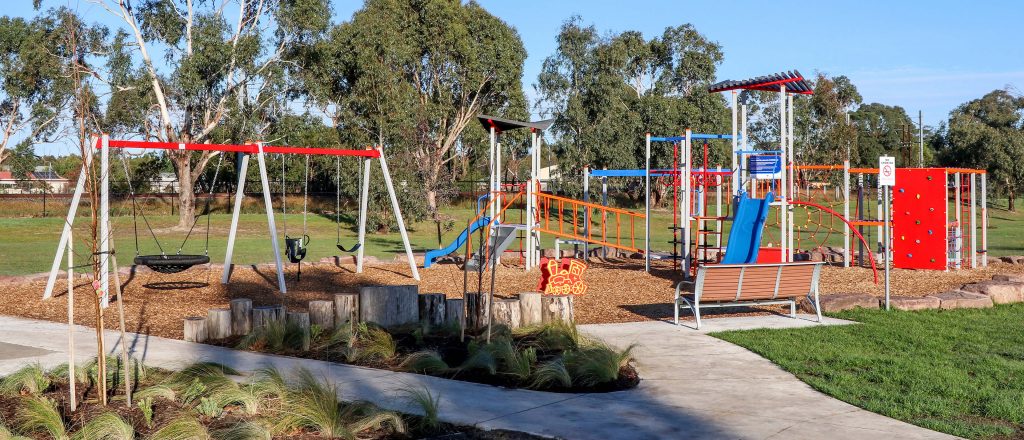Product added to your enquiry
Video: Have You Created an Effective Play Space?
The balance between engaging and safe
Huge amounts of hard work go into creating a successful outdoor playground. Children need space where they can play, explore, socialise, learn and develop vital cognitive and social skills. Play spaces, however, need to strike a balance between being engaging and safe.
An effective playground creates the environment for children to feel safe to explore on their own, and to be themselves away from the confines of home or the classroom. Adult supervision should only be present to assist the kids rather than lead them to do certain activities.
As such, There is a lot of time and effort expended by landscape architects, project managers and local government officials in designing and creating safe and effective play areas for community parks. adventure+ enjoys playing a necessary part in the process by providing engaging and unique playground equipment that meets Australia’s safety standards.
Still, how do we ensure that the play spaces we create are effective in creating a stimulating but safe playground?? How do we know it has met its objectives?
The good news is that the indicators are there. By asking the following questions, the answers will give you a clear indication of whether or not your play space design is performing as intended. From there, you will know which elements to improve or replace to make sure your outdoor playground serves its true purpose.
Q1. Does the playground get used?
“The proof is in the pudding.” In this case, it’s in the using. The true acid test of any good play space design is that it gets used. Playgrounds aren’t built to be empty. Observation over time can provide a clear indication as to whether residents are interested and engaged, because if they are, they’ll come back again and again.
Q2. How long do people stay?
Engaging playgrounds engross children for a long time.
Ever taken your children to a playground and they are tired of everything in the first five minutes? This indicates that it’s not fulfilling one of its core objectives – engagement. A great playground fosters a child’s imagination and provides them with lots of options for play and opportunities for physical and creative expression.
Not all parks can be the flagship fun zones. Some simply don’t have the capacity. Different parks have different expected lengths of visit. A pocket park, for example, will only expect to entertain children for a shorter period of time, but a destination regional playground should occupy children and their families for hours.
Q3. Are the residents satisfied? Or worse, are they registering complaints?
While a community’s overall satisfaction is not as easily observable, it is a method of assessing whether your play space is successful.
Many councils conduct surveys on the effectiveness, assessing which playgrounds are most popular and why. And councils also receive complaints about some playgrounds.
What is your council hearing?

7 Tips For Creating Effective Playgrounds
1. Keep The User In Mind Throughout The Process
Always keep in mind who the playground is developed for — the children are its primary audience. Children are naturally curious, and playgrounds should encourage them to discover their interests and explore new types of play. Play spaces should also feel and look interesting and familiar. You can play around with colours, themes, textures and tactile elements to make the space more interesting for kids.
2. Consider Parents, Supervisors, & Care Givers Too
Play areas need to suit the needs of parents and carers If they don’t like going there, they won’t bring their children. Easy access, shade, seating, parking, facilities and safety are all key factors to be considered.
3. Balance Form & Function
Ensure a balance between architectural design and play value. Again, designing first for the children and not just a fine-looking portfolio piece. As landscape architect Nicholas Rose from Urban Edge Landscape Architects said, “The theme should not outweigh the opportunities for play and enjoyment of the space.”
4. Be Inclusive & Accessible
Incorporate a wide variety of play opportunities. Provide for all ages and abilities. A playground should be inclusive and accessible to everyone in the target age groups. Make sure it has play structures and facilities suitable for children with special needs and easy access for their carers.
5. Create Space For Individual Play As Well As Group Play
Include areas where children can play together or alone. Children, especially those with sensory issues, can become easily overwhelmed by too much stimulus. need time and space to play alone and then re-join others. Consider a balance of small, independent play areas and collaborative spaces.
6. Incorporate Nature
A great play space incorporates nature. A lot of open and green space is ideal for ground-level play. Also, elements such as sand and water provide a dynamic environment that allows children to explore their surroundings through their senses. This helps them develop their motor skills and learn to express, recognise and manage their feelings and emotions.
7. Consider How You Can Customise
Consider customisation. It helps if you create a playground that is tailored to the location, size, history of the area and number of visitors to the playground. You can employ custom design services to make sure your new or revamped outdoor playground meets the needs of its target users.
Creating play can be hard work, but we know it’s worth it! adventure+ are experts in designing, building and installing customised community playgrounds.
To find out how we can assist with the needs of your community, contact our team on 1300 237 587 or sales@adventureplus.net.au today!